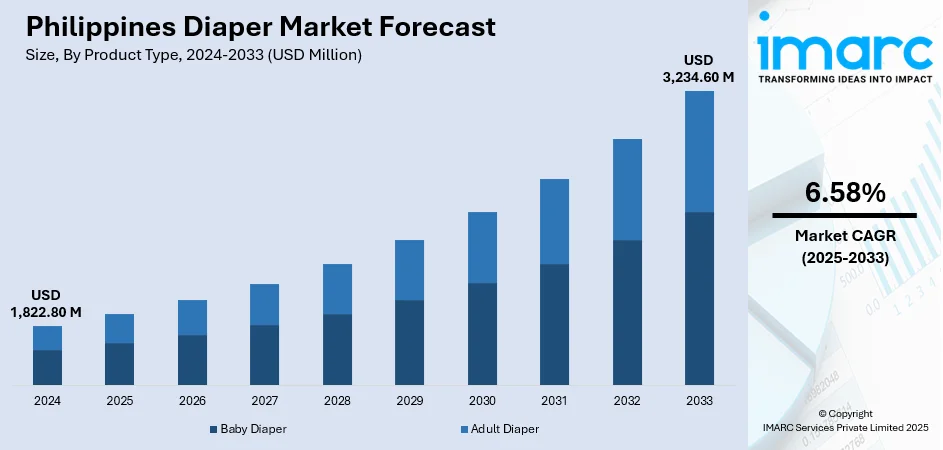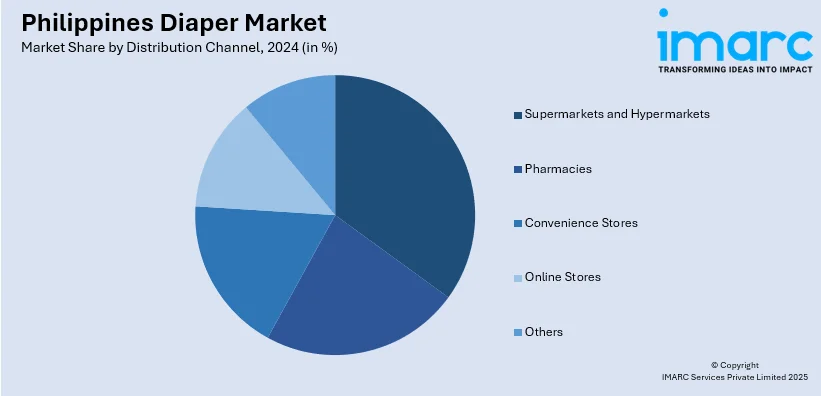
Philippines Diaper Market Size, Share, Trends and Forecast by Product Type, Distribution Channel, and Region, 2025-2033
Philippines Diaper Market Overview:
The Philippines diaper market size reached USD 1,822.80 Million in 2024. The market is projected to reach USD 3,234.60 Million by 2033, exhibiting a growth rate (CAGR) of 6.58% during 2025-2033. The market is experiencing steady growth, driven by rising birth rates, improved hygiene awareness, and increasing disposable incomes. Urbanization and the growing number of working mothers are also fueling demand for convenient and high-quality diaper products. Both disposable and eco-friendly variants are gaining popularity, with local and international brands competing through innovation and affordability. E-commerce platforms further support market expansion by increasing product accessibility across regions. These factors contribute to the expanding Philippines diaper market share.
|
Report Attribute
|
Key Statistics
|
|---|---|
|
Base Year
|
2024
|
|
Forecast Years
|
2025-2033
|
|
Historical Years
|
2019-2024
|
| Market Size in 2024 | USD 1,822.80 Million |
| Market Forecast in 2033 | USD 3,234.60 Million |
| Market Growth Rate 2025-2033 | 6.58% |
Key Trends of Philippines Diaper Market:
Demographic Shifts Fuel Diaper Consumption Growth
The Philippines continues to experience sustained demand for baby and adult diapers, driven by its high birth rate and rising elderly population. Urban consumers are particularly drawn to the hygiene, comfort, and convenience provided by modern diaper products, which suits fast-paced lifestyles. Consequently, retailers and e-commerce platforms are expanding their assortments to include size-specific packs and adult incontinence solutions. The robust middle-income expansion has also made disposable diapers more accessible across economic strata. As extended families adopt adult diaper use alongside infant care, hygiene products are becoming a regular household purchase. Multinational brands are investing in localized production and marketing campaigns, while domestic players innovate with affordable, eco-conscious alternatives. In September 2024, Jiayue, a leading hygiene-products manufacturer, highlighted that the Philippines welcomes nearly 2 million newborns annually, sustaining steady demand for infant care products across both urban and rural markets. This demographic-driven increase not only boosts volume but reinforces Philippines diaper market trends, underscoring the product’s essential role across multiple life stages and family structures.

To get more information on this market, Request Sample
Eco-Conscious Choices Expand Green Diaper Sector
Environmental awareness is beginning to influence Filipino caregiver preferences, increasing interest in plant-based and biodegradable diaper options. Recent market reports highlight the rise of "Eco Boom" diapers made primarily from bamboo, wood pulp, or compostable materials—in response to local landfill concerns and sustainable development goals. These diapers appeal to parents seeking both ecological benefits and premium comfort. They often come with certifications such as FSC and OEKO-TEX and feature minimal plastic and compostable packaging. While still emerging, green diaper lines are gaining traction among urban middle-income households, supported by retailers promoting eco-responsible messaging. Early adopters report these diapers decompose significantly faster than conventional options. This eco-conscious purchasing shift indicates that biodegradable diapers are moving toward becoming mainstream offerings. This transition is a key component of the market, reflecting how sustainability considerations are reshaping product development and consumer demand.
Digital Expansion and Subscription Model Adoption
The digital transformation of retail in the Philippines is reshaping how diapers are purchased. The rise of e-commerce platforms offering subscription services, bundle deals, and scheduled diaper replenishments aimed at providing busy parents with convenience and consistency. These services allow customization by diaper size, frequency, and product line, reducing the burden of frequent store visits. Logistics companies have scaled up next-day delivery services, while users benefit from eco-friendly, trackable packaging and notifications for order replenishments. Subscription models generate data insights to suppliers, enabling production planning and demand forecasting. Loyalty programs and timely promotional offers further enhance consumer engagement. As digital infrastructure expands in both metropolitan hubs and regional provinces, this purchasing model is gaining widespread traction. This shift in retail behavior significantly contributes to Philippines diaper market growth, modernizing distribution channels and aligning the sector with global digital commerce trends.
Growth Drivers of Philippines Diaper Market:
Product Innovation and Technological Advancements
Continuous improvements in diaper design, materials, and manufacturing processes are driving the market forward. Companies are launching products that are ultra-soft, lightweight, and highly absorbent, which are more comfortable and offer protection to the skin. Other enhanced products like wetness indicators, adjustable waistbands, and hypoallergenic layers attract the conscious parents who want premium quality products to be used by their offspring. At the adult diaper level, the emphasis on design considerations includes new design solutions where discreet and odor-control design considerations meet the needs of users concerned with comfort and dignity. Such updates not only help to increase functionality but also invite consumers to purchase higher versions of the products. The presentation of high performance, ease of use, and skin support promotes brand loyalty, giving the manufacturers an opportunity to boost their market presence and carve out a bigger pie of the transforming diapers industry.
Expanding Retail and Distribution Networks
The growth of modern trade channels, convenience stores, and pharmacy chains across urban and semi-urban areas is enhancing diaper accessibility in the Philippines. According to the Philippines diaper market analysis, this expansion allows consumers to purchase products easily, increasing overall adoption rates. Additionally, partnerships between manufacturers and local retailers ensure a steady supply and promotional visibility. Traditional retail outlets continue to play a key role, particularly in rural markets, where brand awareness campaigns and competitive pricing help drive penetration. The integration of omnichannel strategies, where physical retail complements online availability, further strengthens consumer reach. By improving product visibility and availability across multiple channels, diaper brands can cater to diverse customer needs, supporting steady market growth across both baby and adult diaper categories.
Rising Health and Hygiene Awareness
Increased public education on personal hygiene and infant care has significantly fueled the Philippines diaper market demand. Parents are becoming more aware of the health risks associated with prolonged exposure to moisture, leading to a preference for high-quality, fast-absorbing diapers that protect against rashes and infections. Public health campaigns, medical endorsements, and maternal care programs reinforce the importance of using diapers for infant well-being and elderly care. This awareness also extends to adult incontinence management, with healthcare professionals recommending specialized products for comfort and hygiene. As consumers place greater value on safety and cleanliness, they are more willing to invest in trusted, performance-oriented brands, fostering consistent market growth in both urban and rural settings.
Philippines Diaper Market Segmentation:
IMARC Group provides an analysis of the key trends in each segment of the market, along with forecasts at the country and regional levels for 2025-2033. Our report has categorized the market based product type and distribution channel.
Product Type Insights:
- Baby Diaper
- Disposable Diaper
- Training Diaper
- Cloth Diaper
- Swim Pants
- Biodegradable Diaper
- Adult Diaper
- Pad Type
- Flat Type
- Pant Type
The report has provided a detailed breakup and analysis of the market based on the product type. This includes baby diapers (disposable diaper, training diaper, cloth diaper, swim pants, and biodegradable diaper) and adult diapers (pad type, flat type, and pant type).
Distribution Channel Insights:

- Supermarkets and Hypermarkets
- Pharmacies
- Convenience Stores
- Online Stores
- Others
A detailed breakup and analysis of the market based on the distribution channel have also been provided in the report. This includes supermarkets and hypermarkets, pharmacies, convenience stores, online stores, and others.
Regional Insights:
- Luzon
- Visayas
- Mindanao
The report has also provided a comprehensive analysis of all the major regional markets, which include Luzon, Visayas, and Mindanao.
Competitive Landscape:
The market research report has also provided a comprehensive analysis of the competitive landscape. Competitive analysis such as market structure, key player positioning, top winning strategies, competitive dashboard, and company evaluation quadrant has been covered in the report. Also, detailed profiles of all major companies have been provided.
Philippines Diaper Market News:
- January 2025: Lazada Philippines, through its Lazada for good initiative, played a crucial role in typhoon relief by donating nearly 1,000 packs of baby diapers to Cabuyao City, Laguna. Partnering with multiple diaper brands, Lazada leveraged its platform to streamline donations and deliver essential aid efficiently. CEO Carlos Barrera highlighted Lazada’s commitment to supporting communities during crises. This initiative not only shows Lazada’s corporate social responsibility but also reinforces its position as a trusted partner in times of need.
Philippines Diaper Market Report Coverage:
| Report Features | Details |
|---|---|
| Base Year of the Analysis | 2024 |
| Historical Period | 2019-2024 |
| Forecast Period | 2025-2033 |
| Units | Million USD |
| Scope of the Report |
Exploration of Historical Trends and Market Outlook, Industry Catalysts and Challenges, Segment-Wise Historical and Future Market Assessment:
|
| Product Types Covered |
|
| Distribution Channels Covered | Supermarkets and Hypermarkets, Pharmacies, Convenience Stores, Online Stores, Others |
| Regions Covered | Luzon, Visayas, Mindanao |
| Customization Scope | 10% Free Customization |
| Post-Sale Analyst Support | 10-12 Weeks |
| Delivery Format | PDF and Excel through Email (We can also provide the editable version of the report in PPT/Word format on special request) |
Key Benefits for Stakeholders:
- IMARC’s industry report offers a comprehensive quantitative analysis of various market segments, historical and current market trends, market forecasts, and dynamics of the Philippines diaper market from 2019-2033.
- The research report provides the latest information on the market drivers, challenges, and opportunities in the Philippines diaper market.
- Porter's five forces analysis assist stakeholders in assessing the impact of new entrants, competitive rivalry, supplier power, buyer power, and the threat of substitution. It helps stakeholders to analyze the level of competition within the Philippines diaper industry and its attractiveness.
- Competitive landscape allows stakeholders to understand their competitive environment and provides an insight into the current positions of key players in the market.
Key Questions Answered in This Report
The diaper market in the Philippines was valued at USD 1,822.80 Million in 2024.
The Philippines diaper market is projected to exhibit a CAGR of 6.58% during 2025-2033.
The Philippines diaper market is projected to reach a value of USD 3,234.60 Million by 2033.
Key trends in the Philippines diaper market include rising demand for eco-friendly and biodegradable products, increasing adoption of premium and ultra-soft variants, and growth in adult diaper usage due to an aging population. Expanding e-commerce channels and innovative marketing strategies are further shaping consumer preferences and driving market evolution.
The Philippines diaper market is driven by rising birth rates, increasing awareness about hygiene, and growing disposable incomes. Expanding urbanization, wider product availability through retail and e-commerce, and innovations in comfort and absorbency further boost demand, supporting market expansion across both baby and adult diaper segments.
Need more help?
- Speak to our experienced analysts for insights on the current market scenarios.
- Include additional segments and countries to customize the report as per your requirement.
- Gain an unparalleled competitive advantage in your domain by understanding how to utilize the report and positively impacting your operations and revenue.
- For further assistance, please connect with our analysts.
 Request Customization
Request Customization
 Speak to an Analyst
Speak to an Analyst
 Request Brochure
Request Brochure
 Inquire Before Buying
Inquire Before Buying




.webp)




.webp)












